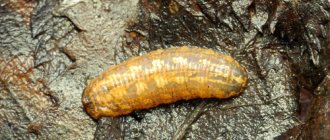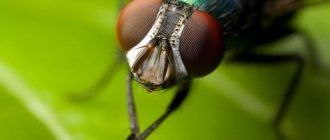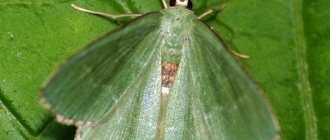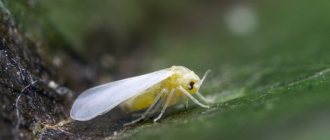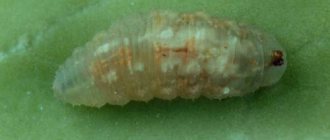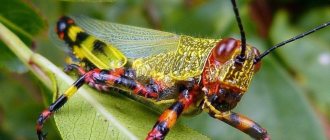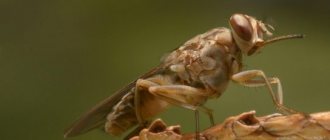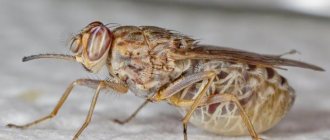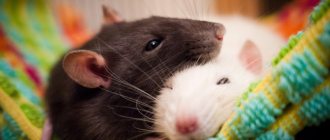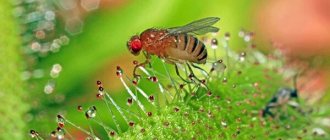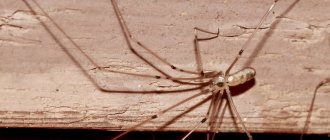The fly is a two-winged nuisance insect from a species of arthropod.
It received this name back from ancient Slavic times from the word “mus”, which translates as “gray”.
What does a fly look like?
Everyone probably knows what this insect looks like, but it’s still worth looking at the presented photos of various flies.
The length of its body ranges from a millimeter level to two cm. The hairy body of the fly has two wings with membranes, a fairly voluminous head and a belly with three pairs of legs.
The mouth is designed like a proboscis that sucks in liquid food. The fly's legs have fairly developed sharp segments and sticky pads that allow it to stay upside down on any surface.
The insect's eyes are designed in a particularly unique way; they contain thousands of hexagonal crystals, which allows the fly to simultaneously see what is happening from absolutely any direction (even the background), that is, it has a circular field of vision. Whiskers are capable of detecting and recognizing many different scents.
Necrophages
Necrophagous flies
The names of fly species can often be misleading. Such a species as the “dust fly” does not exist in nature. This name most often hides lucilia, which belongs to the group of necrophages. In the garbage dumps themselves, you can find any synanthropic species, including fruit flies. The group of necrophagous flies of the most famous flies includes:
- Lucilia (green);
- gray meat;
- blue meat
They all feed on animal carcasses, but also include food scraps, plant juices and excrement in their diet.
Interesting!
Necrophages are easy to distinguish from other dipterans: all these flies have red eyes. Some may have blood red (gray blowfly) or brick eyes (green).
Lucilia
A very common and well-known emerald green fly, capable of laying eggs on meat left unattended for a couple of minutes.
They often lay eggs in open wounds, where larvae begin to develop by eating rotting flesh. The main habitat of these dipterans near human habitation is slaughterhouses. But larvae can also develop in animal excrement. It takes 1-2 days for the larvae to develop from the egg.
Blue meat
Medium sized insect. Distributed across all continents. Like the green one, it prefers slaughterhouses and decaying meat.
Gray meat
One of the most dangerous carrion flies. Outwardly, it is similar to an ordinary indoor one, but larger and with clearly visible bright red eyes on its head. The species is viviparous. The female only needs to touch the meat with her belly to lay the larva. When emerging, the larva immediately begins to bite into the meat. The location of the larvae's penetration can be determined by the appearance of liquid from decomposing meat.
Habitats and food of flies
The fly insect is a very heat-loving arthropod and does not tolerate drops in temperature at all. Its habitat is almost the entire globe, excluding cold Antarctica.
They give preference to residential areas, closer to people and animals. The fly can be observed in homes during the warm season, where it invades from early spring to late autumn.
The life of an insect is quite short - a maximum of 2.5 months.
Flies eat almost any organic food that is pre-soaked with their saliva. Sweets occupy the first place in its diet, but there are also exceptional individuals who choose raw vegetables.
Useful
Even ordinary flies can be considered useful, since they are orderlies - they destroy garbage, expired food and other leftovers.
Slightly less common are pollinating flies, such as the honey bee. But if it enters the body, it can cause various infections.
Hoverfly or syrphid
Very similar to a wasp. In the summer, you can see such a fly hovering over flowering plants, or near a cluster of garden aphids.
This specimen is safe for humans. It feeds on the nectar of inflorescences and spider mites. The buzzing of a fly resembles the sound of rushing water, which is why it got its beautiful name.
Hematophagous
Hematophagous flies
Flies that bite are obligate hematophagous flies. This species feeds on blood in its adult stage. The larvae develop in rotting organic matter. Obligate hematophages include: horse flies, autumn flies and tsetse flies, which are often called killer flies.
Interesting!
The largest flies are called horse flies because of their thirst for blood. The female, trying to drink blood and lay eggs, does not feel danger, does not notice anything around her and often dies from the tail of an animal or the hand of a person.
In horseflies, females differ from males in that humans usually do not even see the latter. Male horseflies feed on nectar and do not attack mammals.
Some species of horse flies have green eyes, which is why they are often confused with other large flies with green eyes - aphage botflies.
All obligate hematophages have mouthparts adapted to obtain blood.
Facultative hematophages are not able to independently obtain blood from the victim’s body. They feed on secretions of the skin and mucous membranes. They willingly drink blood protruding from fresh wounds. In addition to secretions, they feed on mammal excrement and plant juices. The larvae develop in excrement.
A typical representative of a facultative hematophage is the market fly, which is very similar to the house fly, but lives only in the southern regions. Distributed throughout Central Asia and Transcaucasia. In Russia it lives in the subtropical zone.
Photo of a fly
Afagi
Species that do not consume any food as adults. Particularly dangerous aphages include gadflies, whose larvae feed on the soft muscle tissue of their hosts or parasitize in the intestines.
On a note!
Contrary to popular belief, the gadfly does not bite or lay eggs under the skin.
Bodfly eggs, depending on the species, are either stuck to the animal’s fur, laid on the grass, or injected into the nose and eyes. The hatched larva makes its way under the skin or into the intestines.
Chloromyia formosa
Adults of this beautiful species of fly fly grow up to 1 cm in length, and received their name due to the unusual coloring of the body and limbs.
Females are blue-green with a purple tint, but males are copper-green with a metallic sheen. The wings are yellow, almost transparent, but the legs are black with yellow spots on the knees.
Their range is quite extensive, from the Far East to North Africa. Females and males feed on plants, sometimes acting as the only pollinators of rare flowers and plants.
3
Athericidae
The remains of this insect were found in China in Jurassic deposits. The most ancient ancestors of modern flies of the order Tabanomorpha led an ectoparasitic lifestyle.
Modern flies grow up to 18 mm and have an unusual cone-shaped body structure. Huge red eyes stand out on the small head. Usually black with thin white stripes. Another characteristic feature is their long legs, which make them look like mosquitoes.
Most of them feed on nectar, but females of some species feed on blood to produce offspring.
4
Read more about Sleeping sickness
In Russia, there is almost no possibility of contracting this disease due to the absence of carriers of the pathogen. But travelers and charity workers who end up in Central Africa. Medicine in these regions is poorly developed, and a vaccine is extremely difficult to find, so a fly bite can be fatal.
Fortunately, regardless of the classification of types, fly bites will not necessarily lead to illness, since not every fly is a carrier. Symptoms are specific and appear within three days to several weeks after the disease, which gives the affected person time to heal. After a fly bite, the following symptoms may occur:
- The appearance of a painful ulcer at the site of the bite;
- The temperature is kept at a consistently high level;
- Rash and itching all over the body;
- The face swells;
- Lymph nodes thicken;
- Body weight drops noticeably for no apparent reason.
Sometimes the victim experiences an enlarged spleen, and kidney and heart diseases begin. Sleep patterns are disrupted, the person loses coordination and complains of confusion. All this develops over a period of a couple of weeks to several months after infection. Lack of treatment leads to death in most cases.
Coprophagous
Among others, obligate flies include some species of the family of true flies that live in pastures. These insects contribute to the breakdown of excrement in nature and are difficult to classify as pests or dangerous flies. But sometimes they fly into houses, carrying worm eggs. In addition, these types of flies often settle in premises where animals are kept.
Facultative flies are much more dangerous, since adult flies feed on excrement, but also willingly eat human food. Often these species fly in to eat directly from a dung heap. The food of the larvae is excrement.
The most typical and widespread representative of facultative coprophages is the housefly. This is one of the most common types of flies in Russia, so adapted to life in human homes that it is practically no longer found in nature.
Appearance of a housefly
In the photo of a housefly, with macro magnification, you can clearly see all the details of the coloring. But when viewed with the naked eye, the fly looks gray.
This is a small insect with an average length of 7 mm. The color of house flies is gray with four longitudinal black stripes on the chest. The belly is yellowish on the underside. The eyes are large and dark red. The eye structure is faceted. The male differs from the female in the distance between the eyes: in females, the length of the organ of vision is equal to the distance between them; in the male, the eyes are spaced 2/3 of the way.
Nutrition
A housefly is an insect that is not capable of biting through human skin, although the female needs protein food to reproduce. This type of fly feeds only on liquid food. When finding solid pieces of organic matter, the housefly dissolves them in saliva before consuming them.
Cereal flies / Chloropidae
In total, about 3,500 species of this family live on the planet, and there are more than 500 species in Russia alone. One of the subspecies was discovered in Baltic amber.
They grow up to 8 mm. There are no cells at the base of the wings, and the prothorax is decorated with dark stripes. Small individuals are usually black with yellow stripes. Among all the diversity there are saprophages and predators that feed on insects and larvae.
They can cause great harm to agricultural crops, and, as the name implies, to cereals. In Africa and in the tropical zone of the planet there are species that act as carriers of dangerous diseases.
By the way, on our website most-beauty.ru there is an interesting article about the most unusual insects.
5
Ktyri / Asilidae
Predatory dipterous insects settled on all continents except Antarctica. The largest populations are found in the subtropics. For example, in California there are more than 500 species, but in cool Norway there are only 20.
The body shape is quite unusual, thread-like, but they are also found with a flattened abdomen. In the Palearctic region there are species whose males grow up to 5 cm, and in the tropics you can find an eight-centimeter fly.
Ktyrs are natural predators that hunt and eat other insects. They have an aggressive disposition and easily fight with wasps and bees.
6
General information
Flies are a collective term for dipteran insects with common morphological characteristics.
The creature's body consists of three parts:
- breast,
- head,
- abdomen.
Most of the fly's head is occupied by the visual system, consisting of simple ocelli and compound eyes. In front there are antennae, a frontal bladder and a mouthparts with a proboscis. The chest, in turn, consists of 3 sections. It contains triangular shields, stigmas, and wings. Paws extend from the chest, at the end of which there are pulvillas, which in insects are responsible for touch and taste. The abdomen has spiracles, a reproductive apparatus, additional segments, and membranes.
Flies are insects with a full cycle of transformation. It includes 3 phases:
- Egg. Oblong, with a whitish tint and a cellular structure. Ripens in 1-3 days.
- Larva. It has three stages of development.
- Adults. Full-fledged flies acquire sexual maturity and the ability to further reproduce 1-2 days after leaving the cocoon.
Some species (for example, botflies and bloodsuckers) are viviparous and bypass the oviposition cycle, immediately releasing larvae.
Buzzers / Bombyliidae
Flies of this family grow from 08 to 30 mm, and their entire body is covered with short fur. This makes them similar to some species of bees and wasps. In addition, they have an elongated proboscis in front.
They settled in tropical and subtropical regions. They feed mainly on nectar. Unlike adults, larvae are predators and feed on the laid eggs of other insects.
The oldest species of buzz fly was discovered in 1985 in layers of the Middle Jurassic period. This fossil species was introduced into scientific circulation by the Soviet zoologist A. Kovalev.
10
Volucella inflata
The large shorthaired fly grows up to 15mm in length and has a wingspan of 10-13mm. It is found in forests, but sometimes flies into orchards growing not far from human habitation.
This species has an unusual color. The breast is black with orange edges. There are orange spots throughout the body. This protective color helps them protect themselves from birds and other insectivorous forest inhabitants.
This unusual fly has spread throughout Europe, from the cold latitudes of Scandinavia to the warm shores of Italy and Spain.
12
